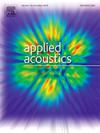MFNSclus: A multi-imaging fusion and clustering method for noise sources identification of permanent magnet synchronous motor
IF 3.4
2区 物理与天体物理
Q1 ACOUSTICS
引用次数: 0
Abstract
Acoustic imaging of permanent magnet synchronous motor (PMSM) faces the challenge of identifying the type of noise sources. A method for identifying PMSM noise sources which involves multi-imaging fusion and clustering is proposed. Firstly, the dominant frequency components of PMSM noise are extracted from multiple measurements using microphone array. Then, acoustic imaging techniques are used to create a map of sound pressure level at selected frequencies. Subsequently, two strategies, coordinate clustering and information clustering, are applied to integrate peak point coordinates, amplitudes, and other information from the sound pressure level map. Finally, the clustering results are combined with the 3D model of PMSM to identify noise sources. Effectiveness of this method was validated by experiments, which revealed that the main noise sources of PMSM are 8 k orders noise and high-frequency noise near the switching frequency due to inverter current harmonics. Compared with traditional acoustic imaging techniques and order analysis, the proposed method provides a 3D noise distribution of PMSM and intuitively represents the types of noise sources.
求助全文
约1分钟内获得全文
求助全文
来源期刊

Applied Acoustics
物理-声学
CiteScore
7.40
自引率
11.80%
发文量
618
审稿时长
7.5 months
期刊介绍:
Since its launch in 1968, Applied Acoustics has been publishing high quality research papers providing state-of-the-art coverage of research findings for engineers and scientists involved in applications of acoustics in the widest sense.
Applied Acoustics looks not only at recent developments in the understanding of acoustics but also at ways of exploiting that understanding. The Journal aims to encourage the exchange of practical experience through publication and in so doing creates a fund of technological information that can be used for solving related problems. The presentation of information in graphical or tabular form is especially encouraged. If a report of a mathematical development is a necessary part of a paper it is important to ensure that it is there only as an integral part of a practical solution to a problem and is supported by data. Applied Acoustics encourages the exchange of practical experience in the following ways: • Complete Papers • Short Technical Notes • Review Articles; and thereby provides a wealth of technological information that can be used to solve related problems.
Manuscripts that address all fields of applications of acoustics ranging from medicine and NDT to the environment and buildings are welcome.
 求助内容:
求助内容: 应助结果提醒方式:
应助结果提醒方式:


